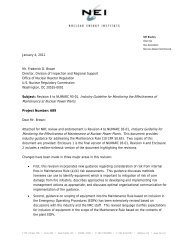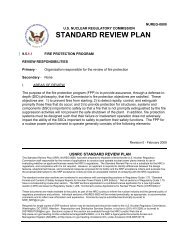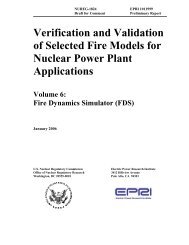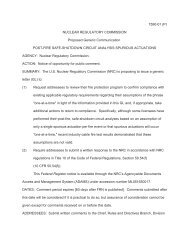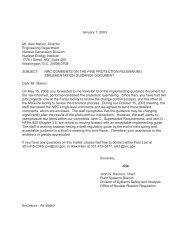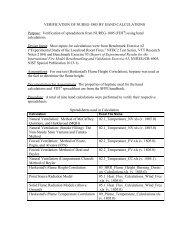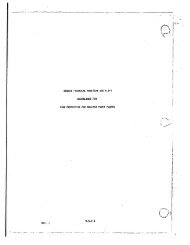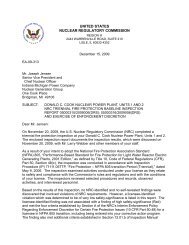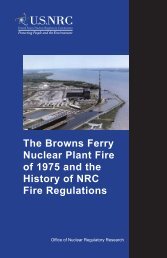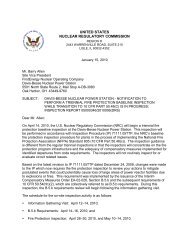NUREG/CR-6850, Volume 1 - NRC
NUREG/CR-6850, Volume 1 - NRC
NUREG/CR-6850, Volume 1 - NRC
Create successful ePaper yourself
Turn your PDF publications into a flip-book with our unique Google optimized e-Paper software.
Overview of the Fire PRA Methodology2-4• Even though the process flow illustrated in Figure 2-1 should work for predominantcases, users may find other analysis task sequences to be more appropriate for theirobjectives. Task sequence choices may, for example, be influenced by plant-specific fireprotection features as well as the availability and depth of plant information supportingthe Fire PRA. Each analysis task incorporates added detail into a given aspect of the FirePRA. Task ordering is subject to practitioner judgment. The analyst may implementalternative task ordering when such alterations provide a more efficient or more effectiveprocess. Indeed, the task ordering applied to one set of fire scenarios may differ from thatused in another set of scenarios within the same overall analysis. Such alterations areacceptable, as long as the principal task interactions described in each analysis taskprocedure are satisfied and overall consistency is maintained.The following is a short description of each technical task for the overall Fire PRA methodology.For further details, refer to the individual task descriptions in <strong>Volume</strong> 2.• Plant Boundary Definition and Partitioning (Task 1). The first step in a Fire PRA is todefine the physical boundary of the analysis, and to divide the area within that boundaryinto analysis compartments.• Fire PRA Component Selection (Task 2). The selection of components that are to becredited for plant shutdown following a fire is a critical step in any Fire PRA. Componentsselected would generally include any and all components credited in the 10 CFR 50Appendix R post-fire SSD analysis. Additional components will likely be selected,potentially including any and all components credited in the plant’s internal events PRA.Also, the proposed methodology would likely introduce components beyond either the 10CFR 50 Appendix R list or the internal events PRA model. Such components are often ofinterest due to considerations of combined spurious actuations that may threaten the creditedfunctions and components.• Fire PRA Cable Selection (Task 3). This task provides instructions and technicalconsiderations associated with identifying cables supporting those components selected inTask 2. In previous Fire PRA methods (such as EPRI FIVE and Fire PRA ImplementationGuide) this task was relegated to the SSD analysis and its associated databases.This document offers a more structured set of rules for selection of cables.• Qualitative Screening (Task 4). This task identifies fire analysis compartments that can beshown to have little or no risk significance without quantitative analysis. Fire compartmentsmay be screened out if they contain no components or cables identified in Tasks 2 and 3, andif they cannot lead to a plant trip due to either plant procedures, an automatic trip signal, ortechnical specification requirements.• Plant Fire-Induced Risk Model (Task 5). This task discusses steps for the developmentof a logic model that reflects plant response following a fire. Specific instructions have beenprovided for treatment of fire-specific procedures or preplans. These procedures may impactavailability of functions and components, or include fire-specific operator actions(e.g., self-induced-station-blackout).• Fire Ignition Frequency (Task 6). This task describes the approach to develop frequencyestimates for fire compartments and scenarios. Significant changes from the EPRI FIVE





